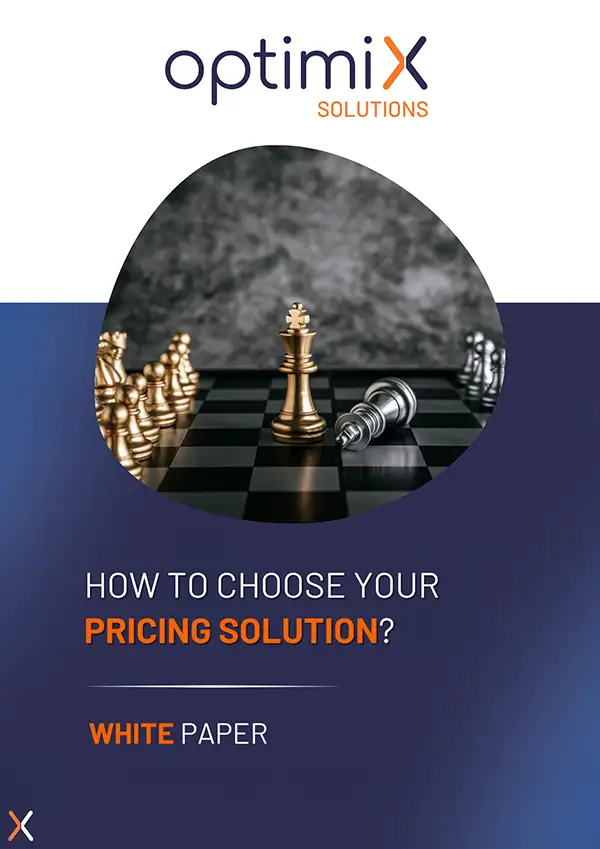Setting a price is more than simply adding up costs and applying a margin. It’s a strategic act, at the crossroads of profitability, brand image and competitive positioning.
Poorly calibrated pricing can slow down sales and damage your brand image. Conversely, a well-designed pricing strategy becomes a true driver of sustainable growth. Relying on pricing tools is therefore essential!
In an environment where consumers compare prices at the click of a button, and competitors adjust their offers in real time, mastering the subtleties of pricing has become essential. It’s a field that’s both analytical and psychological, where data meets intuition, and where every penny can sway a purchasing decision.
In this article, we offer a comprehensive overview of how to understand, build and manage your pricing strategy. After highlighting the key pricing issues, we’ll explore the main pricing methods, the strategic models to adopt depending on your positioning, and the technological tools and indicators to monitor.
Finally, we’ll share common mistakes to avoid if you want to turn your pricing policy into a real competitive advantage.
Why is Pricing Strategy Essential?
A pricing strategy is not just a numerical adjustment; it reflects a fundamental business decision — a strategic lever that shapes the entire company. Your price positioning can influence how consumers perceive your prices.
Its importance lies in its direct and profound impact on several pillars:
- Impact on profitability: Price is the main determinant of revenue. Too low a price reduces margins, while too high a price can limit sales volumes. An optimized pricing strategy guarantees to break even and maximize profits.
- Influence on Positioning and Brand Image: Price sends a strong signal to the market. A high price may suggest superior quality or premium positioning, while a competitive price may attract a budget-conscious clientele. Pricing policy must be aligned with the image the company wishes to project.
- Customer acquisition and loyalty: A fair price, perceived as fair and offering good value, facilitates the acquisition of new customers and strengthens the loyalty of existing ones. The wrong strategy, on the other hand, can lead to high churn rates.
- Competitive advantage: Price is a powerful tool for differentiation. Whether by offering the lowest price or justifying a higher price with exceptional added value, a well thought-out pricing strategy can create a sustainable competitive advantage in the marketplace.
- Demand management: consumer price sensitivity anddemand elasticity are key factors. A detailed understanding of these dynamics enables prices to be adjusted to stimulate or contain demand, depending on the company’s objectives.
The fundamentals of pricing strategy
The development of a robust pricing strategy is based on an inseparable triptych: perceived value, offer positioning and the company’s strategic objectives.
Perceived Value: Beyond Absolute Cost
Customer-perceived value transcends the absolute price of the product or service. What counts is the value/price ratio, a complex equation involving factors such as brand image, rarity, the intrinsic quality of the product or service, and the overall user experience. This feeling, often subjective, is the real driving force behind the purchasing decision.
Positioning: An essential strategic alignment
Pricing policy must be in perfect harmony with the desired positioning of your brand. A brand embodying luxury and exclusivity will naturally opt for a skimming policy, while a Digital Native Vertical Brand (DNVB) might favor competitive pricing in the launch phase, with gradual price evolution. Price reflects brand identity.
Strategic Objectives: The Pricing Compass
Pricing is intrinsically linked to a company’s strategic objectives. Is it to win market share, maximize profit margins, or test a new customer segment? Each objective requires its own specific pricing method.
The different pricing methods
Several methodological levers are available to help companies determine the selling price of their offers.
Cost-Based Pricing: A Traditional but Limited Approach
This traditional method involves aggregating fixed and variable costs and then applying a desired margin. However, its simplicity masks a major risk: it neglects customer-perceived value and competitive positioning, which can lead to prices that are disconnected from market reality. Costing is a starting point, not an end in itself.
Competitive pricing: essential strategic intelligence
Observing and analyzing competitors’ prices is fundamental. The company can choose to match, exceed or undercut these prices, depending on its overall strategy. Nevertheless, care must be taken to avoid falling into a destructive price war, detrimental to the profitability of all players.
Value-Based Pricing: Customer Centricity
This approach is intrinsically focused on the customer’s willingness to pay. It requires an in-depth understanding of the persona, its buying motivations, and its value criteria. In this way, price becomes a direct reflection of perceived value, rather than just the cost of production.
Psychological Strategies: The Subtle Influence on Perception
Psychological pricing techniques are commonly used to influence, often unconsciously, the customer’s perception:
- Magic” pricing: The use of 9 or 99 cent ($9.99) terminations, creating the illusion of a lower price.
- Fare anchoring: Offer a very high-end option to enhance the value of the intermediate offer and make it more attractive.
- Scarcity or urgency effect: Encourage immediate purchase by indicating limited availability or a temporary offer.
When used wisely, these strategies can significantly increase conversion rates.
Different pricing strategies
Pricing strategies are essential levers for adapting your pricing policy to your company’s objectives and market expectations:
- Skimming: this approach consists of launching a product at a high price, then gradually reducing it. It is particularly well-suited to innovations, niche products or products with high perceived value, as in the luxury or tech sectors.
- Penetration: on the other hand, this strategy aims to offer a low price from the outset, in order to rapidly capture market share. It is often found in SaaS, subscription or freemium models.
- Alignment: by aligning with the market average, the aim is to leverage other differentiation levers (quality of service, customer experience, brand image).
- Hybrid models (freemium, upselling, bundling): these mechanisms can be used to create progressive, personalized purchasing paths, which are highly effective in B2B environments or digital services.
For an in-depth analysis of these strategies and their applications, read our full article the different pricing strategies
How do you set up your pricing strategy?
Implementing an effective pricing strategy requires a structured approach: clearly define your objectives, segment your market, choose the right pricing method, and establish a coherent pricing grid.
It’s also crucial to communicate clearly around the price, train your teams, regularly monitor performance, and continuously adjust the strategy through tests such as A/B testing.
To discover these steps in detail, consult our page :
How to set up an effective pricing strategy.
Technology and Data for Pricing Strategy
Today, price optimization relies on fine-tuned, intelligent use of data.
The most effective levers include :
- Dynamic pricing: automatic adjustment of prices according to demand, stock levels or seasonality – widely used in sectors such as hotels, airlines and e-commerce.
- Pricing A/B testing: comparison of two price plans on similar segments to measure their impact on conversion or margin.
- AI and machine learning: predictive modeling of customer behavior in the face of price variations, taking into account weak signals (navigation, basket abandonment, purchase history, etc.).
- Automated competitive intelligence: real-time monitoring of competitors’ prices to enable instant adjustments.
This is the logic behind XPA – Optimix Pricing Analytics, our powerful solution designed to precisely monitor and refine your pricing strategy.
To find out more, read the full article on :
Key tools & technologies for effective pricing strategy management
How do you choose your pricing strategy?
Choosing the right pricing strategy is a crucial step, based on a rigorous analysis of several internal and external factors.
The first step is to clarify the company’s financial objectives: maximizing margins, rapidly gaining market share, or stabilizing growth.
Next, the cost structure must be kept under control to ensure minimum profitability. Precise knowledge of customers and their price sensitivity enables us to adapt our offer to their expectations, while a study of the competition helps us to position our prices strategically.
Finally, it’s essential to take into account the product life cycle and regulatory constraints specific to the sector. By combining these elements, you can define a coherent and effective pricing policy.
To discover the complete approach and expert advice, read our detailed article : How to choose your pricing strategy.
10 criteria for your pricing strategy
An effective pricing strategy is more than just setting the right price. It needs to be regularly evaluated using clear criteria to ensure that it remains aligned with the company’s objectives, consistent with the market and adapted to customer expectations.
Several factors come into play: profitability, competitive positioning, impact on brand image, and the ability to adjust to market variations. All these criteria help us to build a solid, coherent and scalable pricing policy.
To find out more on this subject, we invite you to read the 10 essential criteria for evaluating your pricing strategy.
5 signs that your pricing strategy could be optimized
An effective pricing strategy is essential to remain competitive in an ever-changing market. Yet many retailers are ignoring the signs of an inefficient pricing model.
Warning signs include a drop in sales despite sustained activity, stagnating margins despite good sales, or significant price differentials with competitors. Another common indicator is low stock rotation, often linked to poor price positioning or an ill-adapted promotional policy.
Lastly, a price updating process that is still manual or time-consuming limits responsiveness and accuracy in the face of market changes.
To optimize your pricing policy, it becomes crucial to integrate automated solutions capable of analyzing costs, competitive data and demand in real time. Automation not only increases efficiency, but also enables you to make informed decisions for each product or sales channel.
If any of these signals ring a bell, it’s probably time to review your strategy.
Find out more about the 5 signs to watch out for and the practical solutions to adopt, read the full article here
Common mistakes to avoid in pricing strategy
Pricing is a delicate stage that can have a lasting impact on commercial success.
There are several classic mistakes to avoid if you don’t want to compromise the profitability or perception of your offer:
- Setting a price without market research
Determining a price without analyzing actual demand, customer expectations and perceived value can lead to a price that is out of touch with the market. This risks holding back sales or underestimating consumers’ ability to pay, thus reducing sales potential. - Think only in terms of cost
Basing pricing exclusively on production or acquisition costs ignores the value the customer attributes to the product or service. This approach neglects competitive differentiation and can result in prices that are too low or too high, penalizing both margins and attractiveness. - Rigid pricing
A fixed pricing policy, unable to adapt to market fluctuations, competitor reactions or changing customer expectations, quickly becomes obsolete. Pricing agility is essential to continuously optimize sales performance. - Targeting the wrong customers
Offering a perfectly calibrated price to a segment that doesn’t correspond to your target clientele is tantamount to missing your target. It’s crucial to know your personas and their sensitivity to price, to avoid positioning errors that damage conversion and loyalty.
By avoiding these pitfalls, you maximize the chances of defining an effective and sustainable pricing strategy, perfectly aligned with your objectives and market realities.
Towards ethical and responsible pricing
At a time when consumers are increasingly engaged, price is no longer just a financial transaction.
It becomes a true marker of transparency and social and environmental responsibility. Open communication on cost structures, known as “open pricing”, helps build trust with customers.
Valuing the fair remuneration of suppliers and partners is also a key aspect that reflects the company’s ethical commitment. In addition, some companies are adopting solidarity-based or progressive pricing models, such as “pay what you want” or prices adjusted according to customer income, to make their offers more accessible while respecting their values.
In this way, pricing is an integral part of our corporate social responsibility (CSR) strategy, strengthening both customer loyalty and our positive image with consumers.
Example of a successful pricing strategy
To grow your business, it’s essential to choose the right pricing strategy. Common examples include the penetration strategy, which involves setting a low price to attract customers quickly, or the skimming strategy, which aims to position the product at a high price to target a premium clientele.
Other approaches include perceived value pricing or dynamic demand pricing. The choice depends on the company’s market, objectives and positioning.
To learn more, we invite you to visit this comprehensive page:
Examples of Pricing Strategies and Pricing Techniques







